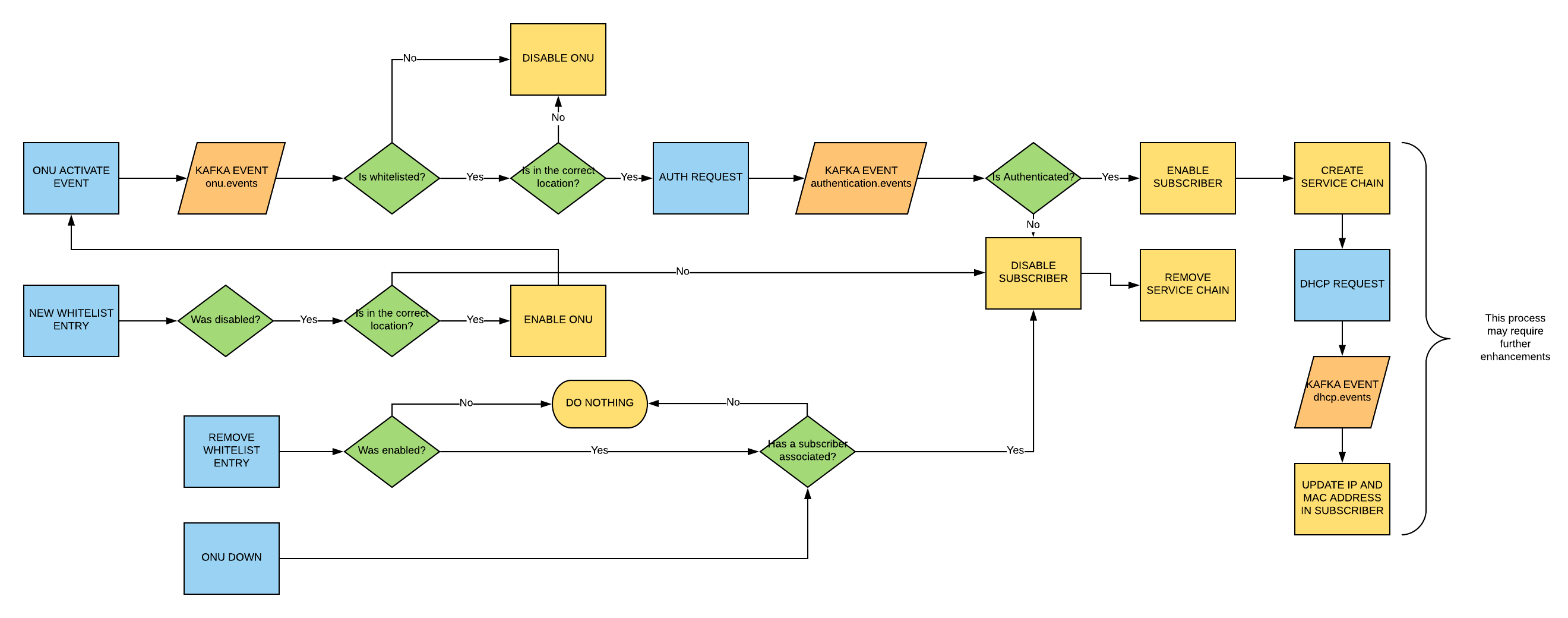AT&T Workflow
You can find a complete description of the SEBA workflow for At&t in this document. This pages focus exclusively on the internals details of the workflow such as actions triggered by the environment and decisions taken by NEM.
Helm charts
To replicate this workflow you'll need to install:
- xos-core
- cord-kafka
- voltha-kafka
- voltha
- onos-voltha
- onos-fabric
- att-workflow
Install the att-workflow chart
helm install -n att-workflow xos-profiles/att-workflow
Workflow description
- ONT discovered bottom-up
- If ONT serial number is not allowed or unknown (i.e it has NOT been provisioned by OSS), disable the ONT; generate an event to external OSS that an ONU has been discovered but not yet provisioned.
- When OSS provisions the ONT, re-enable it & program 802.1x flow - UNI port(s) will be UP
- Ensure that DHCP fails here (because subscriber/service-binding has not been provisioned by OSS yet)
- 802.1x EAPOL message happens from RG, and ONOS AAA app adds options and sends to radius server. Options are pulled from Sadis/NEM - no subscriber information is required here
- If RG authentication fails, allow it to keep trying (in the future consider redirection to captive / self-help portal). DHCP should not succeed since RG authentication has failed
- If RG authentication succeeds, ONOS AAA app notifies via an event on the kafka bus that authentication has succeeded
- NEM can listen for the event, and then check to see if subscriber/service-binding has happened on that port from OSS - if not, then nothing to be done
- Must ensure that DHCP fails here even though RG has been authenticated (because subscriber/service-binding has not been provisioned by OSS yet)
- When OSS provisions the subscriber/service-binding on the UNI port and gives the C and S vlan info, then DHCP trap will be programmed on the port, and DHCP process can start
- If RG is disconnected from UNI port, force authentication again (even if subscriber/service-binding has been provisioned by OSS). Upon reconnection to UNI port, RG must re-authenticate before DHCP/other-traffic can flow on the provisioned VLANs.
- DHCP L2 relay -> add option 82, learn public IP address, forward via dataplane to external DHCP server
This schema summarizes the workflow, please note:
- in
light blueare environment events (wether they are triggered from hardware or from an operator) - in
yelloware NEM configuration calls to ONOS or VOLTHA - in
greenare decisions - in
orangeevent published on the kafka bus

NOTE: when we refer to
service chainwe are talking about the set of subscriber specific service instances that will trigger theadd_subscribercall in ONOS-VOLTHA and provision the crossconnect in ONOS-FABRIC
Operations
We assume your POD is already configured as perthis instructions (you need to complete only the first section)
Whitelist population
To configure the ONU whitelist, you can use this TOSCA:
tosca_definitions_version: tosca_simple_yaml_1_0
imports:
- custom_types/attworkflowdriverwhitelistentry.yaml
- custom_types/attworkflowdriverservice.yaml
description: Create an entry in the whitelist
topology_template:
node_templates:
service#att:
type: tosca.nodes.AttWorkflowDriverService
properties:
name: att-workflow-driver
must-exist: true
whitelist:
type: tosca.nodes.AttWorkflowDriverWhiteListEntry
properties:
serial_number: BRCM22222222
requirements:
- owner:
node: service#att
relationship: tosca.relationships.BelongsToOne
For instructions on how to push TOSCA into a CORD POD, please refer to this guide.
Pre-provision subscribers
You can pre-provision subscribers using this TOSCA:
tosca_definitions_version: tosca_simple_yaml_1_0
imports:
- custom_types/rcordsubscriber.yaml
description: Pre-provsion a subscriber
topology_template:
node_templates:
# Pre-provision the subscriber the subscriber
my_house:
type: tosca.nodes.RCORDSubscriber
properties:
name: My House
status: pre-provisioned
c_tag: 111
onu_device: BRCM22222222
For instructions on how to push TOSCA into a CORD POD, please refer to this guide.
OLT Activation
Once the system knows about whitelisted ONUs and subscribers, you can activate the OLT:
tosca_definitions_version: tosca_simple_yaml_1_0
imports:
- custom_types/oltdevice.yaml
- custom_types/voltservice.yaml
description: Create a simulated OLT Device in VOLTHA
topology_template:
node_templates:
service#volt:
type: tosca.nodes.VOLTService
properties:
name: volt
must-exist: true
olt_device:
type: tosca.nodes.OLTDevice
properties:
name: ONF OLT
device_type: openolt
host: 10.90.0.114
port: 9191
switch_datapath_id: of:0000000000000001
switch_port: "1"
outer_tpid: "0x8100"
uplink: "128"
requirements:
- volt_service:
node: service#volt
relationship: tosca.relationships.BelongsToOne
For instructions on how to push TOSCA into a CORD POD, please refer to this guide.